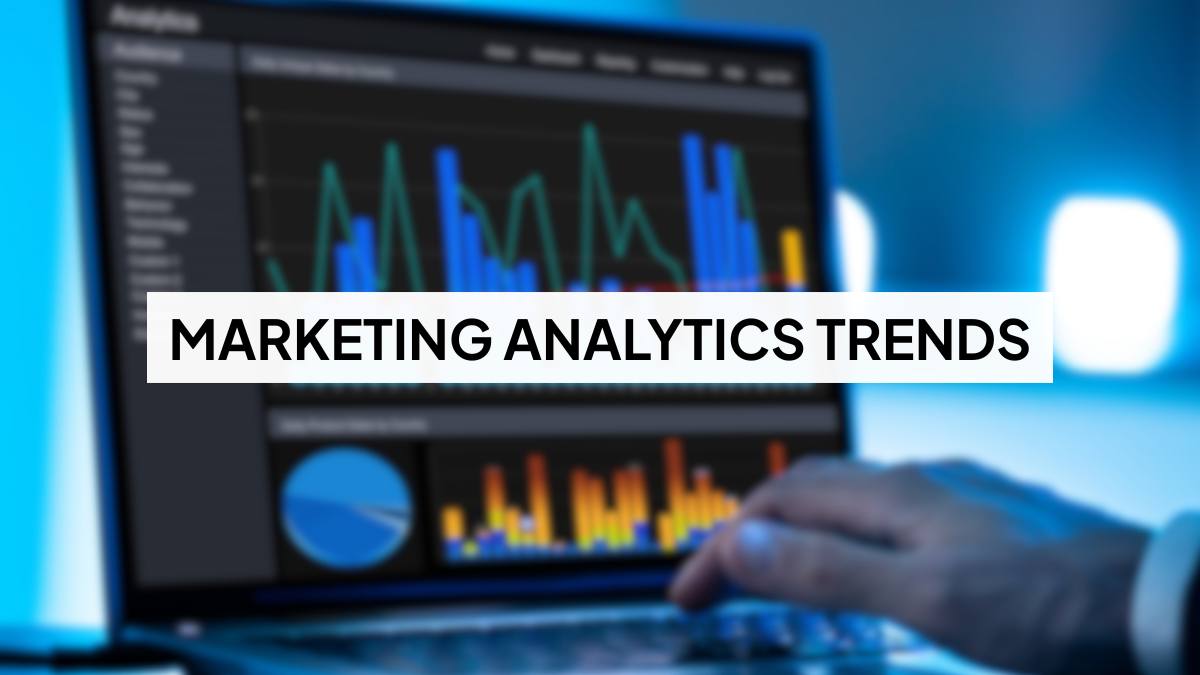Let’s start with a quick story.
Back in the early 2000s, marketing was basically guesswork. You’d run a radio ad, maybe stick a big billboard on a busy street, and hope for the best. If sales picked up, awesome. If they didn’t… you just shrugged and moved on.
Fast forward to now, and honestly, that whole approach feels like something out of a museum.
Today, marketing is all about proof. Businesses don’t just want to know if something worked, they want to know why it worked, how it worked, and what they should do next to make it work even better.
A good example? House of Cards on Netflix. That wasn’t approved because someone at Netflix just loved political dramas. Nope, they looked at the numbers. People who liked political thrillers + Kevin Spacey fans + David Fincher’s directing style = likely hit. Pure data. Pure strategy.
That’s where we’re at now. Data isn’t just part of the process, it’s the fuel that powers everything smart in marketing.
And in 2025, that fuel? It’s high-octane.
So what’s changing? A lot. And the key thing you need to know is this: Marketing Analytics Trends in 2025 are shaping how brands grow, how campaigns get built, and even how products get launched.
AI is doing more of the heavy lifting. Privacy laws are reshaping how we collect and use information. And marketing analytics itself? It’s getting sharper, faster, and a lot more exciting.
Let’s dive into the trends shaping the future of how marketing works.
Table of Contents
What is Marketing Analytics?
Alright, let’s keep this simple. Marketing analytics is just a fancy term for how businesses use data to figure out what’s working in their marketing, and what’s not.
It’s like using a smartwatch, but instead of tracking your steps or heart rate, it’s tracking clicks, conversions, and customer behavior.
You want to know how many people clicked your ad? You got it. Want to see which type of customer buys from you the most? No problem. Want a prediction on what kind of content will perform better next week? That’s where analytics really shines.
But here’s the key part: In 2025, this isn’t just a “nice-to-have” anymore. It’s a must. Nobody’s got time (or budget) to keep guessing what works. Businesses are done wasting money on campaigns that don’t land. They want proof. They want direction.
And with AI stepping into the picture, marketing analytics isn’t just about answering What happened? anymore. Now it’s helping you answer What should we do next?
Alright, let’s talk about what’s changing and what you need to know.
Also Read: Scope of Marketing Analytics
Key Marketing Analytics Trends in 2025
1. AI and Machine Learning Will Redefine Analytics
We’ve been hearing about AI for a while now, right? But 2025 is the year it finally feels normal, like Wi-Fi or smartphones. Not futuristic, just everyday life.
One of the biggest shifts we’re seeing is predictive analytics powered by AI.
It’s not just showing you what happened last week or last month. It’s telling you what’s likely to happen next. Imagine setting up an email campaign and your tool says, “Hey, this subject line has a 76% chance of beating your last one.” How cool is that?
And then there’s Generative AI, which is basically your brainstorming buddy. Not only does it help crunch numbers, but it also spits out fresh ideas for ad copy, new audience segments, and even campaign structures. It’s like having a smart marketing partner on call 24/7.
➡ Want to master AI-driven marketing analytics? Explore our detailed program at Young Urban Project’s AI Marketing Course, designed to help you stay ahead of this shift.

2. Synthetic Data Will Unlock New Opportunities
Now, let’s get into something a lot of people still haven’t heard about: synthetic data.
Basically, it’s fake data that behaves like real data. And no, this isn’t some shady trick. It’s actually super useful.
Why does it matter for marketing? Two big reasons:
First, you can test campaigns without using real customer data. That’s a huge win for privacy, especially with all the new regulations popping up.
Second, it lets you test things faster. Normally, you’d have to wait weeks or months to gather enough customer data to see patterns. With synthetic data, you can create those patterns artificially and test your ideas much quicker.
3. Real-Time Analytics for Instant Decision Making
Remember when marketers would run a campaign for a month and then check results? That’s old news now.
Real-time analytics means you’re optimizing campaigns on the fly. Ads underperforming? Change the creative right now. Certain demographics not converting? Shift your spend immediately.
Faster data → quicker optimization → better ROI.
Some of the tools leading this movement include:
- Google Analytics 4 (GA4) with real-time tracking improvements
- HubSpot for instant lead behavior insights
- Amplitude for product and user engagement data in SaaS
The takeaway? Waiting is expensive. Real-time is where serious ROI happens.
Also Read: Google Tag Manager vs Google Analytics 4
4. Hyper-Personalization at Scale
Personalization used to mean slapping someone’s name in an email. Not anymore.
In 2025, we’re talking about individual-level dynamic personalization. That’s right, instead of segmenting your audience into broad categories, AI helps you create individualized experiences based on behavior, preferences, and context.
Example? Let’s say you visit an online clothing store. The homepage you see isn’t just “Men’s Sale” or “Summer Collection”, it’s “Hey Alex, based on your last purchase, here’s a curated rack just for you.”
AI makes this possible at scale, not just for luxury brands, but even lean e-commerce businesses.
Hyper-personalization doesn’t just drive better conversions, it builds brand loyalty like nothing else.
5. Privacy, Data Ethics & Governance Will Shape Analytics
With great data comes great responsibility. (Yes, I just paraphrased Spider-Man.)
Privacy is no longer a checkbox, it’s a strategy.
With rising privacy regulations like GDPR updates, India’s Digital Personal Data Protection Act, and even stricter rules on AI data collection, marketers are being forced to rethink how they collect and use data.
What’s working now?
- Privacy-first data strategies: Asking users for explicit consent before tracking.
- First-party data: Collecting information directly from customers (think newsletters, account sign-ups, loyalty programs).
If you don’t build trust, you lose attention. Simple as that.
Also Read: Beginners Guide to Marketing Analytics
6. Automation and Autonomous AI in Marketing
Here’s where things start feeling a bit like science fiction, except it’s happening right now.
Automation in marketing analytics used to mean setting up reports that ran every week. But in 2025, we’re seeing the rise of autonomous AI, tools that don’t just collect data, they actually tell you what to do with it.
Imagine logging into your dashboard, and instead of just graphs and numbers, it says:
“Based on current trends, shift 15% of your Instagram budget to TikTok. Engagement there is spiking.”
This isn’t guesswork, it’s machine-driven recommendations based on your unique data.
What does that mean for marketers?
- Less manual analysis
- More strategic human work
- Faster pivots, better outcomes
You become less of a data wrangler and more of a strategist, with AI playing the role of a highly capable assistant.
7. Rise of CRM and Customer Data Platforms (CDPs)
Here’s a simple truth: Data that lives in silos doesn’t work.
That’s why CRMs (Customer Relationship Management systems) and CDPs (Customer Data Platforms) are blowing up in 2025.
Brands are realizing that connecting sales data, website behavior, ad clicks, and customer support conversations gives them a single customer view.
With everything in one place, you can finally build:
- Personalized email sequences
- Tailored offers based on actual purchase history
- Ads that don’t feel like random interruptions
Example: Beauty brands like Sephora are leading here, using loyalty data, website behavior, and store visits to create seamless, personalized marketing experiences across all platforms.
8. Video & Interactive Content for Data Collection
Let’s get honest for a second: People are bored of basic lead forms.
In 2025, interactive content is the secret weapon for better data collection. Why? Because it’s fun, engaging, and gives you richer insights.
Think:
- Shoppable videos that track which products viewers click on
- Gamified quizzes that recommend products and capture preferences
- Polls and surveys embedded in content that feed directly into your analytics stack
Brands like BuzzFeed nailed this early with their viral quizzes, but now even serious B2B brands are using interactive calculators, ROI estimators, and assessments to gather smarter data while adding value.
Bottom line: Better interaction = Better data = Smarter marketing.
9. Analytics Driving Multichannel Optimization
Running a Facebook ad? Cool. Running a Facebook ad and connecting that performance with your email open rates, website traffic spikes, and influencer campaigns? That’s where the magic happens.
Multichannel optimization is all about seeing the whole picture.
In 2025, AI-driven analytics platforms can recommend things like:
“This blog post is trending → promote it via Instagram Stories → link to your webinar → capture leads.”
Instead of marketing channels acting like separate rooms, multichannel optimization turns them into one connected space, making every touchpoint more intentional.
It’s not just about doing more; it’s about doing things smarter.
10. Democratization of Analytics for SMBs
Here’s my favorite trend, honestly.
For a long time, serious marketing analytics was something only big brands could afford. They had data scientists, fancy dashboards, consultants, the works.
But in 2025, AI-powered analytics tools will be finally affordable for small businesses.
Platforms like:
- Piwik PRO for privacy-first analytics
- Zoho Analytics for budget-friendly dashboards
- Surfer SEO for content data optimization
Even solopreneurs are running predictive campaigns with tools that cost less than their daily coffee budget.
It’s leveling the playing field. Startups, creators, local businesses, everyone gets a shot at smart, data-driven growth.
Also Read: Data-Driven Marketing Strategies
Predictions for the Future of Marketing Analytics
Let’s peek into the crystal ball for a second.
In the next 3 to 5 years, expect things like:
- Predictive product launches: Brands using AI to create product ideas before launching based on market gaps
- Fully AI-automated campaigns: You set the goal, and the system runs A/B tests, optimizations, and reports automatically
- Emotion analytics: Advanced AI that reads customer emotions (through video, voice, text) to adjust marketing on the fly
Wild, right? But it’s closer than you think.
Why Businesses Must Adapt to These Trends
It’s simple:
- Adapt = Competitive edge
- Ignore = Irrelevance
Those who lean into these trends are going to spot new revenue streams faster, make fewer mistakes, and build brands that customers trust.
And of course, this all means upskilling is non-negotiable.
Also Read: Best Data Analytics Books
Conclusion
Marketing analytics isn’t just another business buzzword anymore, it’s the backbone of modern marketing. The trends shaping 2025 are big: AI making smarter predictions, synthetic data speeding up testing, real-time analytics helping with faster decisions, and privacy becoming the new currency of trust.
But here’s the thing: You don’t need to master everything at once. Start with what fits your business best. Experiment. Make mistakes. Learn from them.
The future belongs to those who are curious enough to test, patient enough to learn, and bold enough to adapt.
Marketing is changing. Don’t get left behind.
FAQs: Marketing Analytics Trends
1. What is the biggest marketing analytics trend in 2025?
The standout trend for 2025 is how AI is completely reshaping marketing analytics. It’s not just about measuring clicks anymore. It’s about AI predicting what’s likely to work before you launch anything. Plus, with real-time analytics, you can tweak campaigns instantly to boost performance without waiting weeks.
2. How does AI improve marketing analytics?
AI takes massive amounts of marketing data and turns it into clear, actionable insights. It helps predict customer behavior, suggests improvements to campaigns, and often uncovers patterns humans might miss. Basically, it saves time and removes the guesswork, letting you focus more on creativity and strategy.
3. Is synthetic data really used in marketing?
Absolutely. Synthetic data is becoming a serious tool for marketers who want to test campaigns before going live. It lets brands experiment safely, without using sensitive customer data. Industries like finance, healthcare, and now e-commerce are already using synthetic data to fine-tune their marketing without privacy risks.
4. Why is privacy important in marketing analytics?
Customers are more privacy-conscious than ever. With regulations like GDPR and new local laws, brands need to handle data carefully. Prioritizing privacy isn’t just about avoiding fines, it’s about building trust. If customers know their data is respected, they’re more likely to engage with your brand over the long term.
5. Can small businesses benefit from marketing analytics?
Yes, and it’s easier than ever. Tools that were once expensive are now accessible to small businesses and startups. Analytics helps small businesses understand their audience better, create targeted campaigns, and stretch their marketing budget further. Even a small investment in analytics can lead to huge improvements in results.
6. Where can I learn more about AI in marketing analytics?
For anyone serious about staying ahead, Young Urban Project’s AI Marketing Course breaks it all down. You’ll learn how to use AI tools for audience targeting, predictive analytics, and campaign creation, all with practical, real-world examples you can apply immediately to your work.

